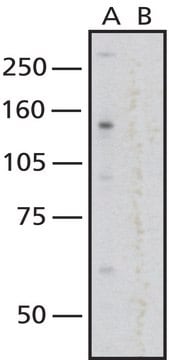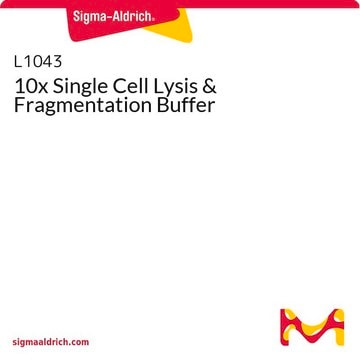Yield will vary between cell lines and sample types, so the expected loss must be determined empirically for each sample. The technical bulletin notes that typical nuclei yields are greater than 30%, but some cell lines and sample types may experience lower yields.
NUC201
Nuclei Isolation Kit: Nuclei PURE Prep
sufficient for 15 nuclei preparations (~1-10×107 cells or 1g of tissue per preparation)
동의어(들):
Sucrose centrifugation nuclei isolation
크기 선택
₩1,168,062
재고 있음세부사항
크기 선택
About This Item
₩1,168,062
재고 있음세부사항
추천 제품
사용
sufficient for 15 nuclei preparations (~1-10×107 cells or 1g of tissue per preparation)
Quality Level
포장
pkg of 1 kit
저장 조건
dry at room temperature
응용 분야
cell analysis
외래 활성
nuclease and protease, free
배송 상태
wet ice
저장 온도
2-8°C
애플리케이션
생화학적/생리학적 작용
키트 구성품 전용
- Nuclei PURE Lysis Buffer 180 mL
관련 제품
신호어
Danger
유해 및 위험 성명서
Hazard Classifications
Aquatic Acute 1 - Aquatic Chronic 2 - Eye Dam. 1 - Skin Irrit. 2
Storage Class Code
10 - Combustible liquids
Flash Point (°F)
Not applicable
Flash Point (°C)
Not applicable
가장 최신 버전 중 하나를 선택하세요:
시험 성적서(COA)
이미 열람한 고객
문서
Centrifugation separates organelles based on size, shape, and density, facilitating subcellular fractionation across various samples.
-
What is the expected loss (%) of nuclei due resulting from the sucrose density gradient purification step? I am planning an experiment with small tissue masses (50-100mg, ~1x10^6 nuclei) and would like to optimise yield as much as possible.
1 답변-
도움이 되었습니까?
-
-
Is the kit compatible to frozen tissue stored in RNAlater?
1 답변-
This kit has not been evaluated for use with frozen samples. It is highly recommended to use fresh tissue samples with product. The freezing and thawing processes could potentially damage many of the cells and nuclei, leading to the loss of functionality/stability of some nuclear molecules/entities.
도움이 되었습니까?
-
-
Is there EDTA present in buffer L9286? Additionally, is the lysis buffer L9286 hypotonic or isotonic/hypertonic?
1 답변-
The lysis buffer is an isoosmotic sucrose buffer and it does contain EDTA.
도움이 되었습니까?
-
-
Is it possible to split the sample in half if the right size tubes for one of the steps are not available?
1 답변-
As per internal notes, the kit can be scaled down to as small as 1.5 ml tubes, provided that the centrifugation speed and time are not deviated from. For example, the sucrose cushion centrifugation step must be carried out for 45 minutes at 30,000 × g, preferably in an ultracentrifuge swinging rotor, as recommended in the Technical Bulletin.
도움이 되었습니까?
-
-
Would the nuclei isolation protocol need to be modified when using NUC201 as an alternative to NUC101-1kt?
1 답변-
The NUC201 and NUC101 kits are very different. NUC101 has two components—a different lysis buffer and a storage buffer. In contrast, NUC201 has a different lysis buffer and a total of 5 kit components. Additionally, DTT needs to be used, although it is listed as a required but not provided reagent. Instructions for Use will be included with each kit. If the procedure is not provided with the kit, a PDF of the kit instructions can be downloaded from the product detail pages for each kit. Due to the significant procedural differences, it is important to use the specific Instructions for Use for each kit.
도움이 되었습니까?
-
-
Is it possible to start the nuclei isolation process from animal tissue or cells by using a frozen sample or cell pellet (kept in -80°C)?
1 답변-
The freezing and thawing processes could potentially damage many of the cells and nuclei, leading to the loss of nuclear components and possible contamination of the nuclei with cytoplasmic or other cellular components. Testing on NUC201 has been conducted on fresh tissue.
도움이 되었습니까?
-
-
Is it possible to start with frozen tissue?
1 답변-
It is probable that the freezing and thawing processes may harm a significant number of cells and nuclei, potentially resulting in the loss of nuclear components and/or contamination of the nuclei with cytoplasmic or other cellular components.
도움이 되었습니까?
-
-
Is the kit compatible with Tris or DTT, as our internal protocol is not compatible with these components?
1 답변-
The NUC201 kit is compatible with Tris as well as DTT. None of the components in the kit, such as sucrose, Triton X100, and glycerin, are known to be incompatible with Tris. Additionally, as these components do not contain sulfur, there is no reason to expect any incompatibility with DTT.
도움이 되었습니까?
-
활성 필터
자사의 과학자팀은 생명 과학, 재료 과학, 화학 합성, 크로마토그래피, 분석 및 기타 많은 영역을 포함한 모든 과학 분야에 경험이 있습니다..
고객지원팀으로 연락바랍니다.















